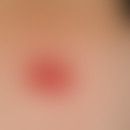Synonym(s)
American trypanosomiasis; Chagom; Trypanosomiasis American
HistoryThis section has been translated automatically.
Chagas, 1909
DefinitionThis section has been translated automatically.
Trypanosome infection transmitted by pirate bugs (see protozoa below).
You might also be interested in
PathogenThis section has been translated automatically.
Trypanosoma cruzi, obligate intracellular parasite.
Occurrence/EpidemiologyThis section has been translated automatically.
- 16-20 million infected in Central and South America, of which about one third are in Brazil. Incidence (worldwide): 200.000-300.000 new cases per year.
- Geographical distribution: Mexico, Central and South America (the southern border is at the level of the northern provinces of Argentina), isolated cases of the disease have been described in the southern states (especially Texas) and in the midwest of the USA.
EtiopathogenesisThis section has been translated automatically.
- Transmission by insect bites of the triatomid family (predatory bug). Numerous animals, especially dogs, cats, monkeys and pigs serve as pathogen reservoirs. Invasion of the reticuloendothelial system in the tissue and spread via the lymph vessel system, later also via the bloodstream. With increasing duration of the disease, infestation of the internal organs, especially heart, muscles and nervous system.
- Transmission also possible by blood transfusion, intrauterine or with breast milk.
ClinicThis section has been translated automatically.
- Incubation period: 5-21 days after transmission by predatory bugs, 30-40 days after blood transfusion.
- Acute phase: Only about 30-50% of newly infected patients develop acute disease symptoms (the acute phase is mostly seen in children!) About 5 days after the sting, there is an inflammatory swelling around the inoculation (Chagoma), e.g. unilateral facial swelling or inflammatory tumour on the back or leg (persisting for several weeks). In case of puncture of the eyelid skin: lid oedema with conjunctivitis = Romana sign. Itching, later regional lymph node swelling. Enlargement of the upper external lacrimal gland. Development of recurrent multiforme-like erythema. Also: fever, generalized edema, hepatosplenomegaly, general lymph node swelling, convulsions, vomiting, diarrhea, dilated cardiomyopathy (most common cause of DCM in Central and South America).
- Latency phase: Long lasting (months-years). Patients are usually free of symptoms. In rare cases, patients suffering from diseases that are associated with a weakening of the immune system ( HIV infection) may experience recurrence of acute symptoms.
- Chronic phase of the disease ( Chagas disease): Subacute or chronic development of myocarditis, cardiomegaly, conduction disorders, cardiac insufficiency, achalasia, encephalomyelitis, megaesophagus, megacolon.
DiagnosisThis section has been translated automatically.
- The detection of parasites is mainly successful in the acute phase of the disease and is less successful due to the low parasite density in the latency phase and the chronic phase of the disease!
- Acute phase: Parasite detection in the chagoco punctate, lymph node biopsy or blood smear (thick drop, native or Giemsa stain).
- Chronic phase: Clinical; CRC; skin reaction with antigen from Trypanosoma cruzi; animal experiments with infection-free bugs (detection of the pathogen several weeks later in the bug feces); detection of antibodies with ELISA, or IFT (6 months after infection almost 100% seroconversion (cross-reactions with leishmaniasis are possible!).
Differential diagnosisThis section has been translated automatically.
Internal therapyThis section has been translated automatically.
Only in the acute phase of the disease did drug therapy show good results (curative in 80-95%); even in the latency phase this is very controversial. In the chronic phase of the disease the benefit of drug therapy could not yet be proven.
- Drug of the 1st choice is nifurtimox (e.g. Lampit). Adults 8-10 mg/kg bw/day p.o. in 4 ED, children 15-20 mg/kg bw/day over 4 months, Cave! Toxicity!
- Alternative: Benznidazole (e.g. Radanil, Rochagan, Ragonil) 5-7 mg/kg bw/day for at least 2 months. Healing in 6 weeks up to 3 months, otherwise transition to the chronic stage (see Chagas disease).
- Additional therapy with paracetamol (e.g. Ben-u-ron Tbl.) 3 times/day 500 mg. Regular internal medical check-ups for the involvement of the internal organs, if necessary intensive medical care.
Cave! Meningoencephalitis is often the cause of death in sick children!
ProphylaxisThis section has been translated automatically.
Measures to create hygienic housing conditions. Predatory bugs are controlled with insecticides. Individual protection against predatory bugs (mosquito net, fly screen). Predatory bugs are active at night!
LiteratureThis section has been translated automatically.
- Chagas C (1909) On a new human trypanosomiasis. Archive for Marine and Tropical Hygiene 13: 351-353
- Chagas C (1909) Nova tripanosomiase humana. Estudos sobre e morfologia e o ciclo evolutivo do Schizotrypanum cruzi n. gen. n. sp. agente etiologico de nova entidade morbida do homem. Mem Inst Oswaldo Cruz 1: 159-218
- Kirchhoff LV (2003) Changing Epidemiology and Approaches to Therapy for Chagas Disease. Curr Infect Dis Rep 5: 59-65
- La Forgia MP (2003) Cutaneous manifestation of reactivation of chagas disease in a renal translant patient: Long term follow-up. Arch Dermatol 139: 104-105
- Prata A (2001) Clinical and epidemiological aspects of Chagas disease. Lancet Infect Dis 1: 92-100
Incoming links (9)
Chagas suffering; Chagom; Dilated cardiomyopathy; Megacolon, toxic; Predatory bugs; Protozoa; Swelling of the eyelids; Trypanosoma cruzi; Trypanosomiasis, american;Outgoing links (7)
Brucellosis (overview); Chagas suffering; Dilated cardiomyopathy; Hiv infection; Leishmaniasis (overview); Malaria; Protozoa;Disclaimer
Please ask your physician for a reliable diagnosis. This website is only meant as a reference.








